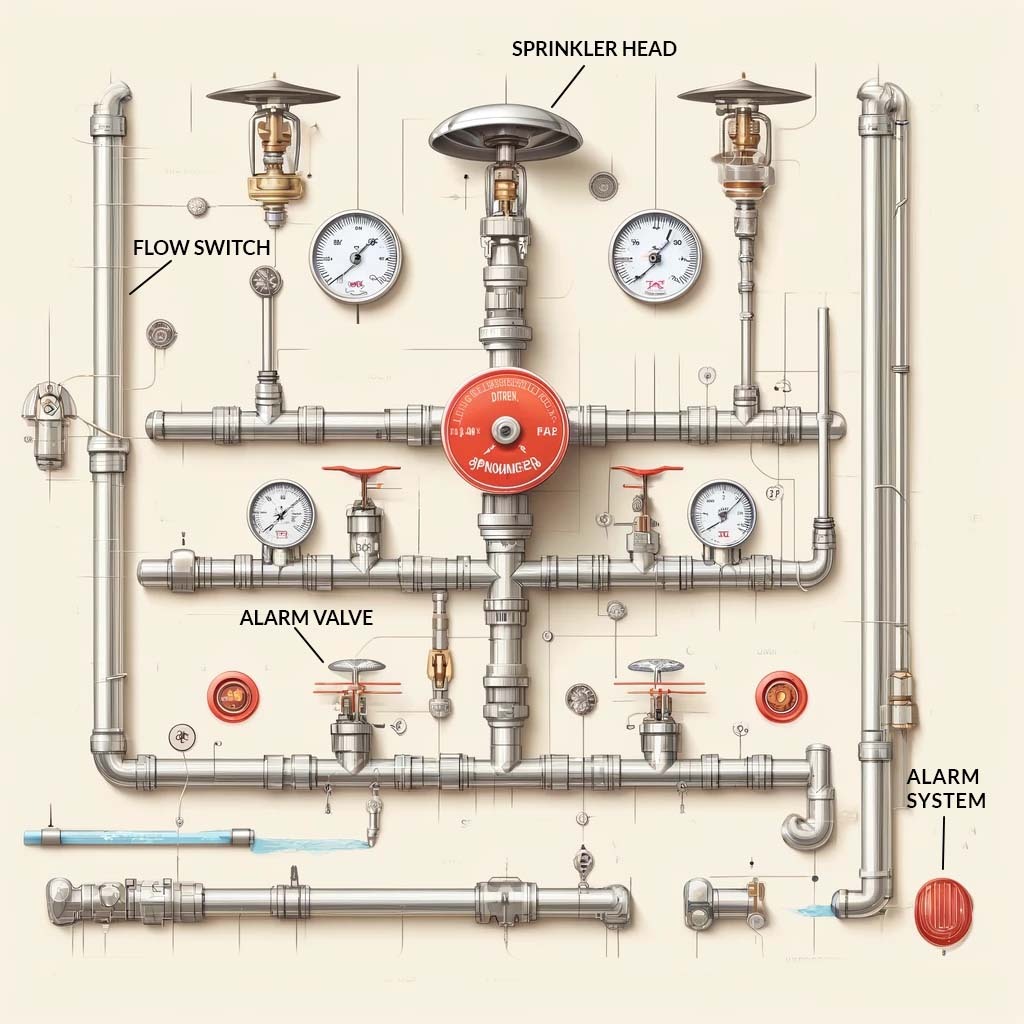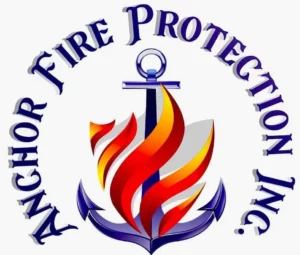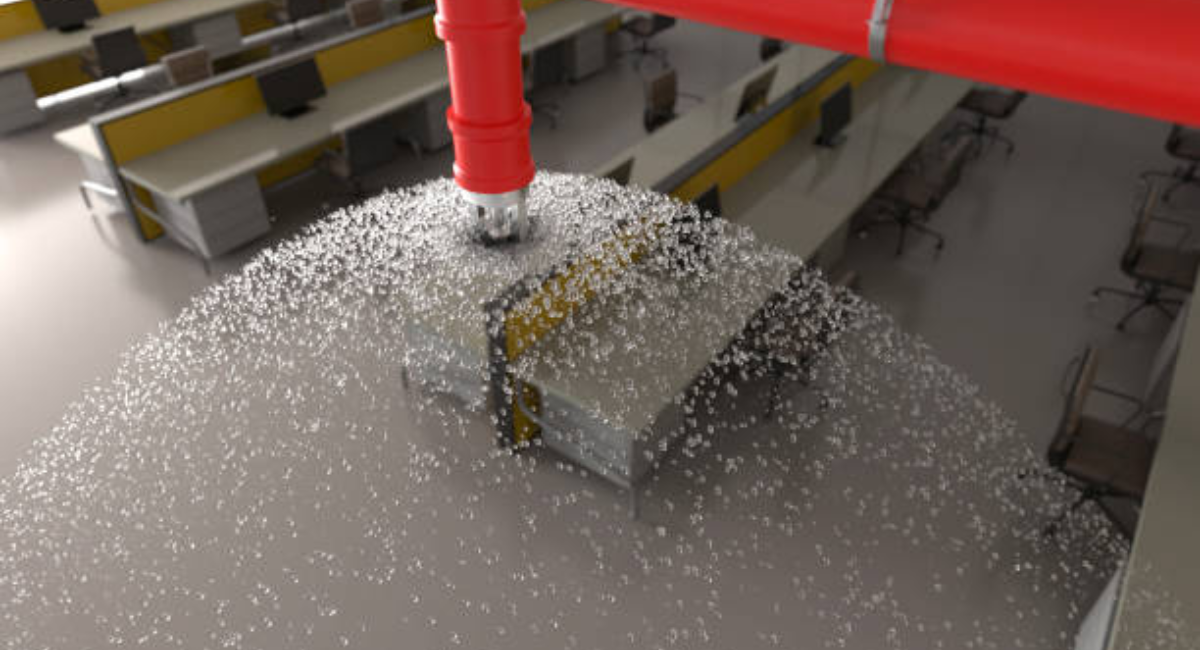Components of a Fire Sprinkler System: What Every Building Owner Should Know
Pipes, sprinkler heads, gauges, control valves, a water flow alarm, and a supplementary drain are the main fire sprinkler system components provided by Anchor Fire Protection. Pressurized water is transported throughout a building by interconnecting pipes, which are usually composed of PVC or galvanized steel. Sprinkler heads are arranged in a pattern along the pipes, and when they are turned on, they release water at a predetermined rate and with control. Gauges can monitor the water pressure in pipes and detect any changes in pressure that may indicate a leak. Control valves can manually turn off water during emergencies or maintenance and manage the amount of water that is sent from the supply to the sprinkler heads.
A measurement of your water pressure and supply will be taken before the sprinkler system is installed, and it will be built to match the specifications of your building. To minimize water damage, fire sprinklers sense heat from a fire and release water that effectively puts out the flames. They offer a life-saving service that can safeguard both your property and the people inside, making them the best type of fire protection for your building. You can recognize the vital components of a fire sprinkler system with the help of this fire sprinkler system parts diagram. Continue reading to learn about the components that make up a fire sprinkler system.
Fire Sprinkler System Components

The key components of your fire sprinkler system and their significance will be discussed in detail next.
Pipes and Water Supply
When a fire breaks out, a system of pipes opens, sending pressured water to the sprinkler heads. These pipes, which are often made of PVC or galvanized steel, manage the pressure. Pipes quietly link sprinkler heads to the water supply, whether they are mounted on walls or ceilings. The four primary piping systems are deluge for high fire danger, pre-action for cautious activation, wet pipe for fast reaction, and dry pipe for freezing locations.
The Sprinkler Heads
A fire sprinkler head is usually overlooked on the ceiling unless there is a fire, at which point it goes into action. It is a heat sensor that has a tiny glass bulb inside of it that is liquid-filled. When a fire heats the surrounding air, the water is released to extinguish the flames, causing the liquid to expand and the bulb to shatter. Fire sprinkler head components include a heat-sensitive element, a sealing mechanism, a deflector, and a sprinkler head nozzle.
There are several varieties of sprinkler heads to choose from. Certain types function automatically by detecting heat, while others work in a manner like fire alarms, needing the glass bulb to be manually broken to start the water flow. Dry systems are used in very cold areas to keep pipes from freezing. They work by pressurizing air until a fire causes the water to be released. The placement determines which sprinkler head to use; hidden heads are typically found in residences and offices.
Alarm Valve, Motorized Alarm & Alarm Check Valve
The alarm valve, one of the most essential fire sprinkler system parts, opens when water arrives, lifting the clapper off its seat and allowing water to flow into the alarm line. An alarm bell with a mechanical water motor is connected to this line. The motorized alarm signals people to call emergency services when water flows through. The alarm check valve also makes it possible to test the sprinkler system while the facility is shut off, which makes it easier to conduct weekly fire pump checks without flooding the building every time.
The Stop Valve
The stop valve, which is often red, needs to be locked in the open position at all times. When the fire sprinkler system is not working, the stop valve prevents water from entering the system from the municipal water supply. A different valve monitor determines whether the stop valve is open or closed.
Pressure Gauges & Pressure Switches
Fire sprinkler pressure gauges measure the air or water pressure. Every five years, gauge replacement is required by NFPA25. The proper functioning of fire sprinkler systems is dependent on stable water pressure. Pressure levels are monitored using strategically placed gauges. A sizable dip might indicate a sprinkler head leak or malfunction, informing building management to take appropriate action.
Pressure switches serve as silent alerts. When a sprinkler head activates or a pipe bursts, the switch sets off the fire alarm system, notifying authorities if the pressure lowers. In addition to monitoring the alarm system for drops in water pressure following the activation of the alarm valve, this permits the sprinkler system to alert the fire brigade.
Control Valves, Fire Pump & Jockey Pump
Control valves in sprinkler systems manage the flow of water. Water flow to the fire sprinklers is stopped by closing the valve. Normally, the valve should stay open, but it might be closed for upkeep, testing, or repairs. When a fire sprinkler head breaks, certain systems immediately trigger control valves; others need manual activation. Certain systems have alarm valves that, upon detecting water flow, activate a fire alarm.
Given that they cooperate with sprinkler systems, fire alarm systems are essential. The alarm system can open the control valve in the event of a fire, allowing for a prompt response and warning building occupants to leave. A fire pump and a jockey pump that is linked to the sprinkler system work together to adjust minor fire sprinkler pressure variations.
The Drain Systems
To keep the system functioning properly, drains are necessary. Experts can use a main drain to remove water from pipes during testing or maintenance. Supplementary drains help prevent water buildup and potential damage by being positioned at low points in the system.
Fire Department Connection
As an additional water source for the building, the fire department uses a connection to pump water into the standpipe or fire sprinkler system. It is located on the outside of the structure and is sometimes referred to as an FDC, or Siamese connection, because of the two inlets. The FDC connects to the discharge side of the pump, and if the fire pump malfunctions, the pump system of the fire engine can supply the sprinklers.
Fire System Components
The several parts of a fire system work together to detect, suppress, and contain flames.
- Fire Alarm Systems: These use heat, flame, or smoke sensors to identify fires. After that, they turn on alerts and notification devices like sirens or strobe lights to alert neighbors and emergency personnel.
- Fire Suppression Systems: These are systems that actively put out or control flames. The most popular kind is the automatic fire sprinkler system, which releases water when a fire is detected by using a network of pipes and sprinkler heads.
- Manual Fire Alarm Pull Stations: In the case of a fire, building occupants can manually activate the fire alarm system by pulling on these red break-glass boxes.
- Fire Alarm Control Panel: This is where the fire alarm system’s main hub is located. It accepts signals from starting devices like smoke detectors, etc., and activates notification devices like alarms using predefined protocols.
- Notification Appliances: These gadgets notify residents about a fire. They include both audio (bells and sirens) and visual (strobe lights) alerts to keep residents informed.
- Fire Extinguishers: Portable fire extinguishers are intended to put out small flames and should not be used instead of a fire suppression system.
- Fire Dampers: These specialty valves are fitted into ventilation systems and, in the case of a fire, close themselves automatically to stop the spread of smoke and flames via ducting.
How do fire sprinklers work?
There are four varieties of fire sprinklers available. The most common type is the wet pipe version, which has pipes designed to hold water in case a sprinkler head activates. In fire sprinklers made of dry pipe, pressurized air, or nitrogen, is contained in the piping of this system and is released through the sprinkler head before water flow. If the temperatures in your building are low enough to cause standing water in a wet pipe system to freeze, you might need this kind. Whatever fire sprinklers you select, keep the following points in mind regarding how they work:
- Sprinkler heads open one at a time to minimize water damage when putting out fires; they do this by activating when exposed to intense heat rather than smoke, which reduces accidental discharge.
- A sprinkler system protects your house or place of business around the clock. In two-thirds of activated sprinkler fires, one or two heads are sufficient to extinguish the flames.
- Sprinklers minimize water damage since they use less water than the fire department and have a faster response time.
Working Together in Harmony
Every component in a fire sprinkler system serves an important purpose. Pressurized water supply, pipe system, watchful pressure gauges, active sprinkler heads, flow-controlling valves, and silent but crucial drains—all work in unison to detect and put out fires before they do significant damage. You can appreciate the measures that keep you safe when you are aware of these fire system components. Regular maintenance and inspections are essential to ensure that your fire sprinkler system is always ready to go when called upon.
Seek help right away to get started if you run into a problem and are not familiar with the various components of a fire sprinkler system or their important functions. We assist those who are new to the fire sprinkler industry, as well as property managers and building owners looking for information on essential system maintenance.
FAQS
Fire sprinkler systems operate using a network of pipes carrying pressurized water. When a fire heats the area around a sprinkler head, a heat-sensitive device activates the targeted release of water in a spray to extinguish the flames.
PVC or steel pipes are frequently used in fire sprinkler systems. Steel offers resilience to wear and heat, but PVC is a more affordable option for non-critical regions.
Heat-sensitive element: It releases water when it senses a temperature rise. It could be a glass bulb filled with a liquid that expands when heated.
Sealing mechanism: It stores water under pressure until the heat-sensitive component trips.
Deflector: When the water spray is released, it forms an efficient pattern for suppressing fires.
Sprinkler head nozzle: It regulates sprinkler water flow and spray pattern.
- Centrifugal pumps are the most common, which increase water pressure by rotating impellers.
- Positive displacement pumps are helpful for drawing water from open sources such as lakes or pools because they can manage air pockets in the water line.
- Combination pumps are dynamic devices that have the ability to operate as both centrifugal and positive displacement pumps.
KEEP YOUR PROPERTY SAFE
Related posts
-
Fire Safety Tips for the Workplace
-
Fire Safety Tips for Hospitals
-
How to size fire pumps?
-
Different types of sprinklers?
-
What is fire protection system?
-
Fire Extinguisher Inspection
-
Fire Sprinkler System Components
-
What are the most common types of fire pumps?
-
How much does a fire sprinkler system cost?
-
What is active and passive fire protection?

